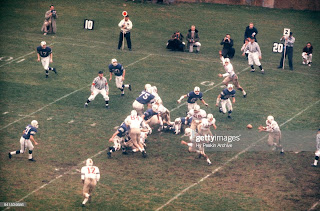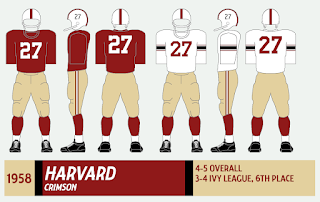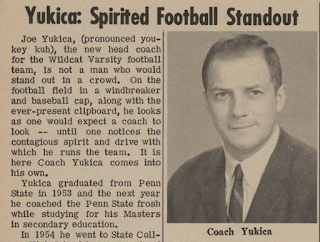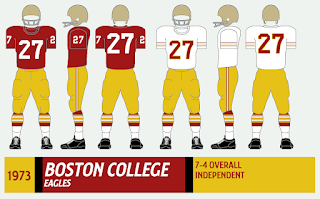Stability is a funny thing in football. Some teams change head coaches more often than their jockstraps (Columbia pre-Al Bagnoli, Maine pre- and post-Jack Cosgrove come to mind), while others have the same coaches year in, year out. New Hampshire recently hired Ricky Santos as its new coach; he's just the Wildcats' third leader since 1972. The Pittsburgh Steelers have had only three coaches since 1969.
Which brings us to Harvard.
The Crimson have enjoyed the services of three coaches since 1957, 65 years ago as of this writing. Sixty-five years before 1957 was 1892, the heyday of helmetless players, the flying wedge and mass-momentum plays. John Yovicsin, Joe Restic and Tim Murphy have been pillars of stability in Cambridge during that time and — not coincidentally — have won plenty of Ivy League titles (17 through 2021, roughly one every four years).
Let's take a look at the uniforms the Crimson wore during the early seasons of each coach's reign, as they all made some changes upon or soon after their arrival.
John Yovicsin was hired in 1957 from Gettysburg, his alma mater, where he went 32-11 over five seasons. After a couple rough seasons at Harvard, Yovicsin guided the Crimson to a 6-3 mark in '59 and Ivy titles in 1961, '66 and '68. His high point as a coach was probably the 29-29 "win" over Yale in 1968 that's been the subject of just a few books and flicks over the years. He retired after the 1970 season because of heart issues.
 |
| John Yovicsin's bio from the 1963 Harvard media guide. |
 |
| Harvard (in white helmets!) faces off with Yale in 1958. Note the black-and-crimson stripes on Harvards jerseys. |
Yovicsin's first-year unis stayed the course from previous seasons, but took a left turn in '58 with the addition of white helmets after decades of crimson lids. In '61 Harvard took it to another level with bizarre half-crimson, half-white helmets before returning to crimson in '64.
Speculation was abound over Yovicsin's possible successor. The Jan. 4, 1971 Harvard Crimson newspaper said "a relatively unknown man" would be hired as coach that day, and noted the rejected candidates were Ralph Jelic, Yovicsin's defensive coordinator, and Frank Ryan, the Cleveland Browns quarterback-turned math professor (fitting for an Ivy school, of course).
The relative "unknown" turned out to be Joe Restic, formerly the head man of the CFL's Hamilton Tiger-Cats (22-17-3 record). Restic soon became very well known around Harvard, going 117-97-6 from 1971-93. He won five Ivy titles and went 10-13 against Carm Cozza and Yale (the 26-year war?). His "multiflex" offense, a whirlwind series of complex plays, formations and last-second shifts, was later the subject of its own class at Harvard.
 |
| Harvard's 1971 media guide heralds the arrival of new coach Joe Restic, in groovy Helvetica font. |
The first-year Restic uniforms were identical to the later Yovicsin versions, put replaced the jersey number with a plain "H" in 1972. In '74, Harvard wore helmets with the "Real Football Centennial" logo (designed as a raspberry to rival Princeton, by my guess) and switched to the H-in-a-hockey-rink logo in '75, albeit with the logo on only one side for couple years. In 1980, the classic jersey with the school seal on the shoulders debuted; the 1988 unis can be found here.
After Restic's retirement in 1993, Harvard turned to Tim Murphy, who had turned around Cincinnati from back-to-back 1-win seasons in 1989-90 to an 8-3 mark in '93. Despite the success story in Cincy, Murphy departed the FBS Bearcats for the FCS Crimson, a curious decision not unlike Joe Yukica's decision to leave Boston College for Dartmouth in 1978.
But there's no arguing with the results. Murphy is by far and away Harvard's winningest coach, with 186 wins and nine Ivy titles, including three undefeated seasons. Murphy also is the fifth-winningest coach in FCS history (210 wins between Harvard and Maine). A few more big seasons, and the FCS record of 242 victories might be in sight.
 |
| Tim Murphy's Harvard debut was a 39-32 win at Columbia. |
Murphy made one significant change to the uniforms upon his arrival: He ditched the hockey rink logo for a more modern H, black and bold and serifed. The height and width of the H changed a few times and the helmet stripes eventually departed, but the rest of the uniform remained largely the same until 2021's overhaul.



































